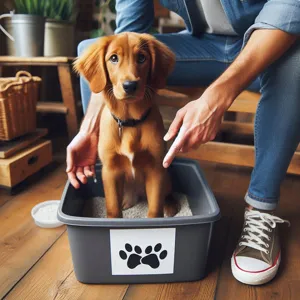If you’re a dog owner, you know how thrilling it can be to come home to an excited pup ready to greet you with wagging tails and joyful barks.
However, that exuberant welcome often comes with an overwhelming leap into the air, leaving you scrambling to maintain your balance and composure. While jumping is a natural expression of excitement for dogs, it can become problematic, especially when greeting guests or in public spaces. Fortunately, with the right approach and a little patience, you can teach your furry friend more appropriate ways to say hello. In this blog post, we’ll explore five effective strategies that will help curb your dog’s jumping habits, allowing for a more relaxed and enjoyable interaction. From positive reinforcement techniques to establishing clear boundaries, these tips will empower you to transform your dog’s behavior and foster a calmer environment for both you and your beloved pet.
1. Understanding Why Dogs Jump

To effectively curb your dog’s jumping habits, it’s essential to first understand the underlying reasons behind this behavior. Jumping is a natural form of communication for dogs, often stemming from excitement, anxiety, or the desire for attention. When your furry friend leaps up to greet you, they are expressing their enthusiasm and affection. In the canine world, jumping can also be a way to establish dominance or assert their presence.
For many dogs, especially energetic breeds, jumping is an instinctive behavior that can be triggered by various stimuli—such as the arrival of guests, the sight of another dog, or even the rustle of a nearby squirrel. Additionally, puppies may jump simply because they are still learning social cues and figuring out how to interact with the world around them.
understanding these motivations is critical. For instance, if your dog jumps when excited, they may be seeking acknowledgment or an invitation to play. Alternatively, if anxiety is at play, your dog might be jumping as a way to cope with stress or fear. Observing the context in which your dog tends to jump can provide valuable insights into their behavior.
By comprehending the “why” behind your dog’s jumping, you can tailor your training approach to address the root causes effectively. This foundational knowledge will empower you to implement strategies that not only discourage jumping but also reinforce positive behaviors, fostering a more harmonious relationship between you and your canine companion.
2. The Impact of Jumping on Behavior and Training
Jumping can significantly impact your dog’s overall behavior and training progress, often leading to complications that can be difficult to manage. When your dog leaps up in excitement, it may seem harmless at first, perhaps eliciting laughter from friends or family. However, this exuberant behavior can quickly escalate into a habit that disrupts daily interactions and can even lead to potential safety concerns, especially for small children or elderly individuals.
From a training perspective, jumping can undermine the foundational commands that are critical for a well-behaved pet. When dogs are allowed to jump without correction, they may misinterpret this behavior as an acceptable form of greeting, making it challenging for them to learn more appropriate behaviors, such as sitting or staying. This inconsistency can become frustrating for both the dog and the owner, leading to a cycle of confusion that hinders effective communication.
Moreover, the impact of jumping extends beyond just initial greetings. A dog that frequently jumps may struggle to focus during training sessions, as their excitement can take precedence over learning. This distraction can stall progress on essential commands, leading to a lack of discipline that may spill over into other areas of behavior, such as leash walking or socialization with other animals.
Understanding the consequences of jumping is crucial for any dog owner. By addressing this behavior early on, you can foster a more disciplined, well-mannered companion who is not only enjoyable to be around but also responsive to commands and training. With the right strategies in place, you can effectively curb your dog’s jumping habits and promote a more harmonious relationship between you and your furry friend.
3. Strategy 1: Consistent Commands and Cues

When it comes to curbing your dog’s jumping habits, establishing a foundation of consistent commands and cues is essential. Dogs thrive on routine and clarity, and by using the same verbal commands and physical cues each time, you can help them understand what behavior is expected of them. start with simple commands such as “sit” or “down.” These commands not only redirect their energy but also provide an alternative behavior that is much more acceptable.
Consistency is key; ensure that all family members and visitors are on the same page regarding the commands used. This uniformity helps to eliminate confusion for your dog, making it easier for them to grasp the desired behavior. For example, if you instruct your dog to “sit” when guests arrive, make sure everyone else does the same. When your dog responds correctly to your command, offer immediate positive reinforcement, such as treats or praise. This not only reinforces their good behavior but also builds a positive association with the command.
In addition to verbal commands, consider using hand signals or body language as cues. For instance, you can raise your hand palm outward to signal your dog to remain calm. Over time, your dog will learn to associate these signals with the desired behavior, providing you with an effective tool to curb jumping. Practice these commands in various settings, gradually increasing distractions to help your dog learn to focus amidst the excitement. By implementing consistent commands and cues, you’ll not only reduce jumping but also deepen your bond with your furry friend through effective communication.
4. Strategy 2: Positive Reinforcement Techniques
When it comes to curbing your dog’s jumping habits, positive reinforcement techniques can be incredibly effective. This method focuses on encouraging desirable behaviors through rewards, rather than punishing unwanted actions. By utilizing treats, praise, and affection, you can teach your furry friend that keeping all four paws on the ground is the way to earn your approval.
To start, it’s essential to identify the moments when your dog typically jumps. Is it when they see you after a long day, or perhaps when meeting new guests? Once you’ve pinpointed these scenarios, you can begin training with consistency. Each time your dog approaches you or a visitor, calmly ask them to sit. When they obey, immediately reward them with a treat or enthusiastic praise. By reinforcing the “sit” command, your dog will learn that staying grounded is more rewarding than leaping into the air.
Consistency is key; make sure everyone in your household is on board with the training. This means no one should inadvertently reward jumping by giving attention or treats when your dog leaps. Instead, everyone should practice the same commands and rewards, creating a unified approach to the training process.
Additionally, incorporating training sessions into your daily routine can provide ample opportunity for practice. Use high-value treats that your dog loves to keep them motivated. Over time, you can gradually phase out treats, replacing them with verbal praise or affection as your dog learns to stay calm.
Remember, patience is crucial. Some dogs take longer to learn than others, so celebrate small victories along the way. With commitment and positivity, you’ll not only reduce your dog’s jumping but also strengthen the bond between you and your furry companion.
5. Strategy 3: Redirecting Energy with Play

Redirecting your dog’s energy with play can be one of the most effective strategies to curb their jumping habits. Dogs are naturally energetic creatures, and if that energy isn’t channeled in the right direction, it can manifest in unwanted behaviors like jumping up on people. By incorporating regular play into your dog’s daily routine, you can help them release pent-up energy in a positive way.
Engaging in interactive games such as fetch, tug-of-war, or even agility exercises can significantly reduce your dog’s urge to jump. When you make playtime a priority, you not only provide an outlet for their exuberance but also strengthen the bond between you and your furry friend. A well-exercised dog is often a calmer dog, less likely to jump out of excitement when greeting guests or family members.
Consider setting aside specific times each day for vigorous play sessions. Whether it’s a long walk around the block, a romp in the backyard, or a trip to the dog park, these activities will help your dog expend their energy. You might also introduce puzzle toys or treat-dispensing toys that encourage mental stimulation, keeping their minds engaged and focused on something other than jumping.
Additionally, during playtime, you can incorporate training by rewarding your dog for keeping all four paws on the ground. Use treats or praise when they stay calm and focused, reinforcing the behavior you want to see. Over time, this will help your dog learn that remaining grounded earns them more attention and fun, creating a positive feedback loop that encourages good behavior.
By redirecting your dog’s energy toward structured play, you can effectively manage their jumping habits while providing them with the exercise and interaction they crave. Remember, a happy, well-played dog is a dog less likely to leap up in excitement!
6. Strategy 4: Teaching Alternative Behaviors
Teaching alternative behaviors is a crucial strategy in curbing your dog’s jumping habits. Instead of simply reprimanding your furry friend when they leap up, focus on redirecting their energy towards more appropriate actions. This approach not only addresses the unwanted behavior but also encourages your dog to engage in positive interactions.
Begin by identifying a behavior that you would like your dog to perform instead of jumping. Common alternatives include sitting, lying down, or even offering a paw. To implement this strategy effectively, you’ll need a handful of treats and plenty of patience.
Start by reinforcing the desired behavior. For instance, when your dog approaches you and is calm, say “sit” and gently guide them into a sitting position if needed. The moment they comply, reward them with praise and a treat. This positive reinforcement helps your dog associate the command with a reward, making them more likely to repeat the behavior in the future.
Practice this new behavior during various scenarios—when guests arrive, during walks, or even during playtime. Consistency is key; ensure that everyone in your household uses the same commands and rewards to avoid confusion. Over time, your dog will learn that sitting (or whatever behavior you choose) garners attention and praise, while jumping will no longer yield the desired response.
Additionally, you can add a cue word or phrase to reinforce the behavior further. For example, saying “hello” when your dog sits calmly can help them understand that this is the appropriate way to greet people. Gradually, with practice and consistency, your dog will replace their jumping habit with a more desirable behavior, leading to more enjoyable interactions and a calmer environment for everyone involved.
7. Strategy 5: Creating a Calm Environment

Creating a calm environment is essential in curbing your dog’s jumping habits. Dogs are highly sensitive to their surroundings, and a chaotic atmosphere can trigger excitement and anxiety, both of which contribute to jumping. By fostering a serene space, you not only help your dog feel more relaxed but also set the stage for appropriate behavior.
Start by designating a specific area in your home that is quiet and free from distractions. This could be a cozy corner filled with your dog’s favorite blankets and toys, where they can retreat when feeling overwhelmed. Consider introducing soft lighting and calming scents, such as lavender or chamomile, to enhance the tranquility of the space.
Establish a routine that includes calming activities, like gentle playtime, relaxed walks, or even some quiet cuddle time. Incorporate training sessions focused on commands that promote calmness, such as “sit,” “stay,” and “down.” These commands not only redirect your dog’s energy but also reinforce a sense of structure.
When guests visit, prepare them in advance about your dog’s jumping habits. Instruct them to ignore your dog until they have settled down, as attention—whether positive or negative—can inadvertently encourage jumping. Additionally, consider using calming music or white noise machines to drown out any sudden sounds that may excite your dog.
By creating a calm environment, you help your dog learn to associate tranquility with their home, making it easier for them to remain grounded and less likely to jump when they feel overwhelmed. With patience and consistency, this strategy can significantly reduce jumping behaviors, leading to a more harmonious relationship between you and your furry friend.
8. The Role of Socialization in Reducing Jumping
Socialization plays a pivotal role in curbing your dog’s jumping habits, offering them a broader understanding of their environment and the various people and animals within it. When dogs are well-socialized, they learn appropriate behaviors and develop the confidence to interact with others without resorting to jumping as a means of greeting or asserting themselves.
Begin socializing your dog at a young age, exposing them to different settings, sounds, and individuals. Take them on walks in busy parks, visit pet-friendly cafes, or attend dog training classes where they can meet other dogs and people. Each new experience helps your pup understand that while excitement is natural, there are more civilized ways to express it than jumping.
As your dog encounters new situations, encourage calm behavior through positive reinforcement. When they meet someone new without jumping, reward them with treats, praise, or affection. This reinforces the idea that remaining grounded is not only acceptable but desirable. Over time, your dog will learn to greet people in a more controlled manner, leading to more enjoyable interactions and a reduction in the jumping behavior.
Moreover, regular playdates with other well-mannered dogs can also be beneficial. These interactions provide your dog with opportunities to practice appropriate greetings and learn from their peers. As they observe other dogs engaging in calm behaviors, they will likely mimic these actions, further solidifying their understanding of proper social etiquette.
In essence, fostering a well-rounded social life for your dog not only curtails their jumping habits but also promotes overall good behavior and a more balanced temperament. Your furry friend will thank you with their newfound composure, making outings and interactions much more pleasant for everyone involved.
9. Tips for Managing Excitement in Different Situations
Managing your dog’s excitement in various situations is key to curbing their jumping habits. Dogs express their enthusiasm and energy in different ways, and understanding these nuances can help you intervene effectively before they leap. Here are some practical tips to help you navigate different scenarios:
**1. Greeting Guests:** When friends or family arrive, your dog may explode with excitement. To manage this, teach your dog to sit and stay before anyone enters the door. Practice this with a friend so your dog learns that calm behavior yields positive attention. You can also equip guests with treats to reward your dog for remaining seated, reinforcing the idea that calmness is desirable.
**2. During Walks:** Dogs often jump out of sheer excitement when they see another dog or person. To prevent this, practice loose leash walking. Carry treats and reward your dog for maintaining a relaxed position by your side. If your dog starts to jump, turn and walk away. This teaches them that jumping leads to missed opportunities for social interaction.
**3. In Crowded Spaces:** Large crowds can heighten your dog’s excitement. To manage this, gradually expose your dog to busy environments at a distance where they feel comfortable. As they grow accustomed to the hustle and bustle, slowly decrease the distance, rewarding calm behavior throughout the process.
**4. During Playtime:** Playdates can be a jumping minefield! Encourage your dog to engage in play with a structured activity like fetch or tug-of-war, which can channel their excitement into a focused task. When play begins to escalate into jumping, take a moment to pause the game and wait for your dog to settle down before resuming.
**5. Teaching the “Off” Command:** A solid “off” command is invaluable in any situation where jumping occurs. Practice this command consistently in low-distraction environments and gradually increase the challenge as your dog masters it. Consistency is key; always reward your dog for obeying the command, and they will learn that keeping their paws on the ground earns them more love and attention.
By implementing these strategies, you can effectively manage your dog’s excitement in various situations, leading to a calmer demeanor and reducing jumping habits over time. With patience and consistency, your dog will learn to express their joy in a more controlled and polite manner.
10. Troubleshooting Common Challenges
When it comes to curbing your dog’s jumping habits, you may encounter a few common challenges that can test your patience and perseverance. Understanding these obstacles is the first step in effectively addressing them.
One frequent issue is the inconsistency in training. If your dog receives mixed signals—being rewarded for jumping up one day and scolded the next—confusion can set in, making it harder for them to grasp what behavior you expect. To combat this, ensure that everyone in your household is on the same page with the rules and training techniques. Consistency is crucial, as dogs thrive on clear expectations.
Another challenge many dog owners face is the excitement factor. Dogs are often overwhelmed with joy when they see their favorite humans, leading to enthusiastic jumps that can be hard to control. In these cases, practice calm greetings. Encourage your dog to sit before they get attention or treats when they greet you. This approach teaches them that calm behavior is the pathway to interaction, not jumping.
You might also notice that certain triggers prompt your dog to jump more frequently—like the doorbell ringing or the sight of other dogs. Identifying these triggers is essential. Consider desensitizing your dog to these stimuli through gradual exposure and positive reinforcement. For instance, practice doorbell drills where you reward your dog for remaining calm and seated when the doorbell rings.
If your dog is particularly stubborn about jumping, it might be beneficial to assess whether their energy levels are being adequately managed. High-energy dogs often resort to jumping out of sheer exuberance. Establishing a consistent routine of physical exercise and mental stimulation can help channel that energy constructively, reducing the likelihood of jumping as a means of expressing excitement.
Finally, remember that patience is key. Behavioral changes take time, and setbacks are a part of the training journey. Celebrate small victories and maintain a positive attitude. With persistence, you can successfully navigate these common challenges and cultivate a more composed and well-mannered canine companion.
11. When to Seek Professional Help
While many jumping habits can be managed with consistent training and patience, there are times when seeking professional help becomes essential for you and your furry friend. If your dog’s jumping has escalated into aggressive behaviors or if they seem overly anxious or fearful in certain situations, it’s crucial to consult a qualified dog trainer or behaviorist.
Professional help is particularly advisable if your dog’s jumping is causing injury to others or themselves, or if it’s creating a significant disruption in your daily life. For instance, if your dog jumps on guests, leading to uncomfortable encounters, or if their excitement causes them to knock over children or elderly family members, these are clear indicators that additional guidance is needed.
Moreover, if you’ve tried various training techniques consistently without success, a professional can offer personalized strategies tailored to your dog’s unique temperament and the specific context of their behavior. They can evaluate the underlying causes of the jumping, whether it stems from excitement, fear, or a desire for attention, and develop a comprehensive plan to address these issues effectively.
Remember, seeking help is not a sign of failure; it’s a proactive step toward fostering a harmonious environment for both you and your dog. A professional trainer can provide invaluable insights, teach you effective communication techniques, and help you establish a training routine that encourages desirable behaviors while appropriately managing those pesky jumping habits. By investing in professional assistance, you’ll be setting the stage for a more balanced relationship with your pet, leading to fewer stressors and a happier household.
12. The Importance of Patience and Consistency
When it comes to training your dog to stop jumping, perhaps the most crucial elements you need to embrace are patience and consistency. Dogs, much like humans, thrive on routine and clear expectations. Recognizing that this is a behavioral change for your furry friend is the first step in setting realistic goals.
Training is not an overnight transformation; it’s a journey that requires your commitment and understanding. Each dog learns at its own pace, and while some may respond immediately to corrections and commands, others may take weeks or even months to fully grasp the desired behavior. Therefore, it’s essential to maintain a calm demeanor and remind yourself that frustration will only hinder progress. Celebrate the small victories along the way, whether it’s a moment of calm when guests arrive or a successful greeting without a leap.
Consistency in your approach is equally vital. This means establishing clear rules that everyone in your household agrees upon and follows. If you allow your dog to jump on you sometimes but reprimand them at other times, it sends mixed signals that can confuse your pup. Use the same commands and cues, and ensure that every family member does the same to reinforce the message.
Additionally, practice makes perfect. Incorporate training sessions into your daily routine, even if they are short. Consistent practice not only reinforces the rules but strengthens the bond between you and your dog. With patience and a unified approach, you will not only curb those unwanted jumping habits but also foster a more respectful and calm relationship with your beloved companion.
13. Celebrating Progress and Small Wins
Training a dog can be a journey filled with ups and downs, and one of the most rewarding aspects of this process is celebrating progress and small wins along the way. Recognizing and acknowledging these achievements not only boosts your dog’s confidence but also strengthens the bond between you and your furry friend. When your dog successfully refrains from jumping during a greeting, even if just for a moment, that’s a win worth celebrating!
Start by setting realistic, incremental goals. For instance, if your dog usually leaps up excitedly when guests arrive, aim for a small milestone—like maintaining all four paws on the ground for just five seconds. When your pup accomplishes this, shower them with praise, treats, or a favorite toy. This positive reinforcement creates a strong association between calm behavior and rewards, encouraging your dog to repeat the desired action.
Keep in mind that progress may not always be linear; there might be days when your dog seems to forget their training or regresses a bit. During these times, it’s crucial to remain patient and focus on the small victories you’ve achieved so far. Celebrate every step forward, no matter how tiny, and use these moments to remind both yourself and your dog of how far you’ve come together.
Consider documenting these milestones, whether through photos, videos, or a training journal. This not only serves as a motivational tool for you but can also help track your dog’s development over time. Plus, sharing your successes with fellow dog owners can foster a supportive community that encourages you to stay committed to your training goals. Remember, celebrating progress in your dog’s behavior not only reinforces their learning but also turns training into a more enjoyable experience for both of you.
14. Recap of Strategies and Next Steps
In this journey of teaching your dog to curb their jumping habits, we’ve explored a variety of effective strategies that not only promote better behavior but also strengthen the bond between you and your furry companion. To recap, here are the key techniques we’ve discussed:
1. **Consistency is Key**: Establishing clear rules and consistently enforcing them is crucial. Ensure that all family members are on the same page regarding acceptable behavior to avoid confusing your dog.
2. **Positive Reinforcement**: Rewarding your dog with treats, praise, or playtime when they remain calm and refrain from jumping reinforces good behavior. This approach encourages them to repeat those actions.
3. **Redirecting Energy**: Providing ample physical and mental stimulation through regular exercise, play, and engaging activities can help reduce your dog’s urge to jump for attention.
4. **Training Commands**: Teaching your dog commands such as “sit” or “stay” not only helps in managing their jumping but also improves their overall obedience. Practice these commands frequently and in various environments to ensure they become second nature.
5. **Controlled Greetings**: Training your dog to greet people in a calm manner can be achieved through controlled introductions. Teach them to wait for an invitation to approach, which sets the tone for polite interactions.
Now that you have a solid understanding of these strategies, what are the next steps? Start by choosing one or two methods that resonate most with you and your dog’s personality. Implement them consistently in your daily routine, gradually introducing additional strategies as your dog begins to respond. Remember to be patient—behavior change takes time and persistence.
Additionally, consider keeping a journal to track your progress. Note any improvements and setbacks, as this can provide valuable insights into what works best for your dog. If you find that you’re struggling despite your efforts, don’t hesitate to seek guidance from a professional dog trainer who can provide tailored advice and support.
With dedication and love, you can successfully curb your dog’s jumping habits and foster a more enjoyable and respectful relationship. Embrace the journey, celebrate the small victories, and enjoy the process of training together!
15. Additional Resources for Dog Training
When it comes to curbing your dog’s jumping habits, having access to additional resources can make all the difference in your training journey. While hands-on training techniques are crucial, supplementing your efforts with various materials and tools can provide new insights and strategies to help reinforce your dog’s good behavior.
Books on dog training are a fantastic starting point. Look for highly-rated titles authored by professional trainers, which can offer in-depth techniques and theories about canine behavior. Many of these books include step-by-step training plans and troubleshooting sections that address specific jumping issues.
Online courses and webinars also present a modern way to learn from experts in real-time. These programs often feature video demonstrations, allowing you to see effective techniques in action. Plus, they frequently provide access to Q&A sessions where you can ask questions tailored to your dog’s unique jumping tendencies.
YouTube is another valuable resource, filled with countless channels dedicated to dog training. These videos can visually guide you through training exercises, making it easier to understand timing and technique. Just be sure to choose reputable trainers to avoid mixed messages or outdated methods.
Consider joining online forums or local training groups as well. Engaging with a community of dog owners can offer support, encouragement, and shared experiences that can help you stay motivated. You can exchange tips, success stories, and even struggles, which can make a significant difference in your training.
Lastly, don’t overlook the importance of professional help. If your dog’s jumping habit proves particularly challenging, enlisting the help of a certified dog trainer or behaviorist can provide targeted strategies and a customized training plan. They can assess your dog’s specific behavior and guide you in implementing effective interventions.
With these additional resources at your disposal, you’ll be well-equipped to tackle your dog’s jumping habits head-on, fostering a more disciplined and well-mannered companion in the process.
In conclusion, curbing your dog’s jumping habits is not only essential for fostering good manners but also for ensuring a safe and enjoyable environment for everyone involved. By implementing these five effective strategies—consistent training, positive reinforcement, providing alternative behaviors, managing greetings, and ensuring adequate exercise—you can significantly reduce your dog’s urge to leap. Remember, patience and consistency are key as you work towards modifying your furry friend’s behavior. Celebrate the small victories along the way, and soon you’ll find that your dog greets you and your guests with calm enthusiasm instead of exuberant jumps. With commitment and love, you’ll transform your pup’s habits, making every interaction a positive experience for both you and your canine companion. Happy training!











